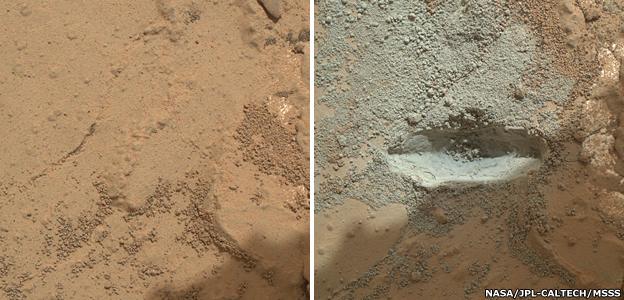Curiosity Mars rover hammers into rock
- Published

Before and after: Curiosity uses its drill system for the first time
The Mars rover Curiosity has used its drill system for the first time.
The robot's tool bit hammered briefly, without rotation, into a flat slab of rock on the floor of Gale Crater, the huge bowl where it landed last August.
Pictures taken before and after the operation reveal the indentation left by the tool's action.
Although previous rovers have scrubbed the surface of rocks, Curiosity, external is the first to carry the capability to drill inside them.
US space agency (Nasa) engineers are taking a step-by-step approach to the procedure.
They need to check both the rock and the drill are behaving as expected.
If the target slab is deemed suitable, a number of test holes are likely to be drilled - using the rotation as well the percussive action - before a powdered sample is picked up and delivered to Curiosity's onboard laboratories.
"The drilling is going very well so far and we're making great progress with the early steps," said Curiosity project scientist Prof John Grotzinger.
"The rock is behaving well and it looks pretty soft, so that's encouraging," he told BBC News.
The rover's mission is to try to determine whether Gale has ever had the environments in the past that were capable of supporting bacterial life.
Detailing the composition of rocks is critical to this investigation as the deposits in the crater will retain a geochemical record of the conditions under which they formed.
Drilling a few centimetres inside a rock provides a fresh sample that is free from the alteration that can occur at the surface as a result of weathering or radiation damage.

The robot arm with its tool turret in position over the John Klein rock. The drill bit is seen touching the ground
Curiosity landed on the Red Planet on 6 August last year.
It has since driven east of its touchdown point to a location that satellite images had identified as an intersection of three distinct geological terrains.
The robot is currently in a small depression dubbed Yellowknife Bay. The rock selected for the first drilling is a very fine grained sedimentary rock cut through with veins of what appear to be a calcium sulphate.
This rock also has a name - John Klein, taken from a recently deceased Nasa engineer who worked on the rover project.
Scientists are thrilled with the progress of the mission so far. Many of the rocks, like the ones in Yellowknife Bay, show clear evidence of deposition in, or alteration by, water.
Shortly before rolling into the bay, Curiosity identified conglomerates containing small rounded clasts, or pebbles, indicating the past presence of fast running water, most likely in a network of streams.

A view from the rover's front hazard avoidance cameras. At left, the bit is raised; at right, it is lowered

This mosaic assembled by Ken Kremer and Marco Di Lorenzo gives a wider context for the Yellowknife Bay drilling operation. The 5km-high Mount Sharp is seen in the distance
You can see more Curiosity mosaics by Ken Kremer and Marco Di Lorenzo at Ken's website, external.
- Published15 January 2013
- Published8 January 2013
- Published4 January 2013
- Published3 January 2013
- Published4 December 2012
- Published4 December 2012
- Published10 September 2012
- Published6 August 2012
- Published25 May 2012